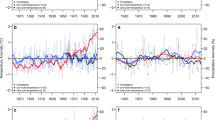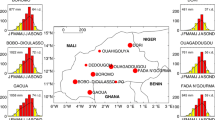Abstract
Relationships between daily precipitation and daily maximum and minimum temperature (Tx and Tn, respectively) are analyzed at station level over the Greater Horn of Africa (GHA). Rainfall occurrence is associated with either above normal Tn (mostly in cool highland areas) or below normal Tn (especially lowland, hot environments and early parts of the rainy season). Tx generally displays a more consistent response to rainfall occurrence, with cooling peaking 1 day after the rainfall event. However there is often a persistence of this cooling several days after the rainfall event, and the amplitude of the cooling is also greater for heavy rainfall events. These temperature anomalies are thought to be a response to cloudiness (concurrent reduced Tx and concurrent enhanced Tn) and soil moisture (reduced Tx and Tn, suggested to reflect evaporative cooling). These relationships are of relevance to the interpretation of temperature trends. From 1973 to 2013, the GHA shows a clear warming signal, for both Tn (+0.20 to +0.25 °C/decade depending on seasons) and Tx (+0.17 to +0.22 °C/decade). Rainfall shows both negative (mostly between February and July) and positive trends (mostly in October–December). Given the superimposition of temperature and rainfall trends in parts of the GHA and the covariations between daily rainfall and both Tx and Tn, regression models are used to extract the rainfall influence on temperature, accounting for lag effects up to 4 days. The daily residuals from these models are used to depict temperature variations independent from precipitation variations. At some stations, trends computed on these residuals noticeably differ from the raw Tx trends. When averaged across the GHA, these effects do not exceed −0.06 to +0.03 °C/decade (depending on the month) for Tx, and are marginal for Tn, thus do not strongly modify the magnitude of the warming in the last 40 years. Nevertheless, these results show that precipitation-temperature relationships must be addressed when analyzing temperature changes.















Similar content being viewed by others
References
Adler RF, Gu G, Wang JJ, Huffman GJ, Curtis S, Bolvin D (2008) Relationships between global precipitation and surface temperature on interannual and longer timescales (1979–2006). J Geophys Res 113:D22104. doi:10.1029/2008JD010536
Berg A, Lintner BR, Findell K, Seneviratne SI, van den Hurk B, Ducharne A, Gentine P (2014) Interannual coupling between summertime surface temperature and precipitation over land: processes and implications for climate change. J Clim 28(3):1308–1328. doi:10.1175/JCLI-D-14-00324.1
Boé J, Terray L (2014) Land–sea contrast, soil-atmosphere and cloud-temperature interactions: interplays and roles in future summer European climate change. Clim Dyn 42(3–4):683–699
Camberlin P, Philippon N (2002) The East African March–May rainy season: associated atmospheric dynamics and predictability over the 1968–97 period. J Clim 15(9):1002–1019
Cheung WH, Senay GB, Singh A (2008) Trends and spatial distribution of annual and seasonal rainfall in Ethiopia. Int J Climatol 28(13):1723–1734
Christy JR (2013) Monthly temperature observations for Uganda. J Appl Meteorol Climatol 52:2363–2372. doi:10.1175/JAMC-D-13-012.1
Christy JR, Norris WB, McNider RT (2009) Surface temperature variations in East Africa and possible causes. J Clim 22:3342–3356. doi:10.1175/2008JCLI2726.1
Collins JM (2011) Temperature variability over Africa. J Clim 24(14):3649–3666
Dai A, Trenberth KE, Karl TR (1999) Effects of clouds, soil moisture, precipitation, and water vapor on diurnal temperature range. J Clim 12(2451):2473
Dai A, Karl TR, Sun B, Trenberth KE (2006) Recent trends in cloudiness over the United States: a tale of monitoring inadequacies. Bull Am Meteorological Soc 87(5):597
Déry SJ, Wood EF (2005) Observed twentieth century land surface air temperature and precipitation covariability. Geophys Res Lett 32(21):L21414. doi:10.1029/2005GL024234
Diem JE, Ryan SJ, Hartter J, Palace MW (2014) Satellite-based rainfall data reveal a recent drying trend in central equatorial Africa. Clim Change 126(1–2):263–272
Elagib NA (2011) Evolution of urban heat island in Khartoum. Int J Climatol 31:1377–1388. doi:10.1002/joc.2159
Elagib NA, Mansell MG (2000) Recent trends and anomalies in mean seasonal and annual temperatures over Sudan. J Arid Environments 45:263–288. doi:10.1006/jare.2000.0639
Evan AT, Heidinger AK, Vimont DJ (2007) Arguments against a physical long-term trend in global ISCCP cloud amounts. Geophys Res Lett 34(4):L04701. doi:10.1029/2006GL028083
Fazzini M, Bisci C, Billi P (2015) The climate of Ethiopia. In: Billi P (ed) Landscapes and landforms of Ethiopia. Springer, Amsterdam, pp 65–87
Fischer EM, Seneviratne SI, Lüthi D, Schär C (2007) Contribution of land-atmosphere coupling to recent European summer heat waves. Geophys Res Lett 34(6):L06707. doi:10.1029/2006GL029068
Funk C, Michaelsen J, Marshall M (2012) Mapping recent decadal climate variations in precipitation and temperature across Eastern Africa and the Sahel. In: Wardlow B, Anderson M, Verdin J (eds) Remote sensing of drought: innovative monitoring approaches. CRC Press, Boca Raton, pp 331–358
Groisman PY, Bradley RS, Sun B (2000) The relationship of cloud cover to near-surface temperature and humidity: comparison of GCM simulations with empirical data. J Clim 13:1858–1878. doi:10.1175/1520-0442(2000)013
Habtemichael A, Pedgley DE (1974) Synoptic case-study of spring rains in Eritrea. Arch Met Geophys Bioklimatol Ser A 3–4:285–296
Harris I, Jones PD, Osborn TJ, Lister DH (2014) Updated high-resolution grids of monthly climatic observations—the CRU TS3.10 Dataset. Int J Climatol 34:623–642. doi:10.1002/joc.3711
Held IM, Soden BJ (2006) Robust responses of the hydrological cycle to global warming. J Clim 19:5686–5699
Hirschi M, Seneviratne SI, Alexandrov V, Boberg F, Boroneant C, Christensen OB, Stepanek P (2011) Observational evidence for soil-moisture impact on hot extremes in southeastern Europe. Nature Geosci 4(1):17–21. doi:10.1038/ngeo1032
Isaac GA, Stuart RA (1992) Temperature-precipitation relationships for Canadian stations. J Clim 5:822–830
King’uyu SM, Ogallo LA, Anyamba EK (2000) Recent trends of minimum and maximum surface temperatures over Eastern Africa. J Clim 13:2876–2886
Koster RD et al (2006) GLACE: the global land-atmosphere coupling experiment. Part I: overview. J Hydrometeorol 7:590–610
Liebmann B, Hoerling MP, Funk C, Bladé I, Dole RM, Allured D, Quan X, Pegion P, Eischeid JK (2014) Understanding recent Eastern Horn of Africa rainfall variability and change. J Clim 27:8630–8645
Liu Y, Key JR, Wang X (2008) The influence of changes in cloud cover on recent surface temperature trends in the Arctic. J Clim 21(4):705–715
Lobell DB, Cahill KN, Field CB (2007) Historical effects of temperature and precipitation on California crop yields. Clim Chang 81(2):187–203
Lyon B, DeWitt DG (2012) A recent and abrupt decline in the East African long rains. Geophys Res Lett. doi:10.1029/2011GL050337
Mekasha A, Tesfaye K, Duncan AJ (2014) Trends in daily observed temperature and precipitation extremes over three Ethiopian eco-environments. Int J Climatol 34(6):1990–1999
Menne MJ, Durre I, Vose RS, Gleason BE, Houston TG (2012) An overview of the global historical climatology network-daily database. J Atmos Ocean Technol 29:897–910
Miralles DG, van den Berg MJ, Teuling AJ, de Jeu RAM (2012) Soil moisture-temperature coupling: a multiscale observational analysis. Geophys Res Lett 39:L21707. doi:10.1029/2012GL053703
Nicholson SE (2015) Long-term variability of the East African ‘short rains’ and its links to large-scale factors. Int J Climatol 35:3979–3990. doi:10.1002/joc.4259
Okoola RE (1989) Interaction between the mediterranean meteorology and conditions over Africa. In: Seminar on tropical meteorology, Erice 26/9-4/10/86. WMO, Technical Document no. 277
Omondi PA, Awange JL, Forootan E, Ogallo LA, Barakiza R, Girmaw GB, Komutunga E (2014) Changes in temperature and precipitation extremes over the Greater Horn of Africa region from 1961 to 2010. Int J Climatol 34(4):1262–1277. doi:10.1002/joc.3763
Omumbo JA, Lyon B, Waweru SM, Connor SJ, Thomson MC (2011) Raised temperatures over the Kericho tea estates: revisiting the climate in the East African highlands malaria debate. Malar J 10:12. doi:10.1186/1475-2875-10-12
Ozer P, Mahamoud A (2013) Recent extreme precipitation and temperature changes in Djibouti city (1966–2011). J Climatol 2013:e928501. doi:10.1155/2013/928501
Rosenzweig C et al (2014) Assessing agricultural risks of climate change in the 21st century in a global gridded crop model intercomparison. Proc Natl Acad Sci USA 111:3268–3273
Soden BJ, Held IM (2006) An assessment of climate feedbacks in coupled ocean-atmosphere models. J Clim 19:3354–3360
Stern DI, Gething PW, Kabaria CW, Temperley WH, Noor AM, Okiro EA, Shanks GD, Snow RW, Hay SI (2011) Temperature and malaria trends in highland East Africa. PLoS One 6:e24524. doi:10.1371/journal.pone.0024524
Stuart RA, Isaac GA (1994) A comparison of temperature-precipitation relationships from observations and as modeled by the general circulation model of the Canadian climate centre. J Clim 7:277–282
Sun B, Groisman PY, Bradley RS, Keimig FT (2000) Temporal changes in the observed relationship between cloud cover and surface air temperature. J Clim 13(24):4341–4357
Tang Q, Leng G (2012a) Changes in cloud cover, precipitation, and summer temperature in North America from 1982 to 2009. J Clim 26(5):1733–1744
Tang Q, Leng G (2012b) Damped summer warming accompanied with cloud cover increase over Eurasia from 1982 to 2009. Environ Res Lett 7(1):014004. doi:10.1088/1748-9326/7/1/014004
Tang Q, Leng G, Groisman PY (2012) European hot summers associated with a reduction of cloudiness. J Clim 25(10):3637–3644
Trenberth KE, Shea DJ (2005) Relationships between precipitation and surface temperature. Geophys Res Lett 32:L14703. doi:10.1029/2005GL022760
Wentz FJ, Ricciardulli L, Hilburn K, Mears C (2007) How much more rain will global warming bring? Science 317(5835):233–235
Williams AP, Funk C, Michaelsen J, Rauscher SA, Robertson I, Wils THG, Koprowski M, Eshetu Z, Loader NJ (2012) Recent summer precipitation trends in the Greater Horn of Africa and the emerging role of Indian Ocean sea surface temperature. Clim Dyn 39:2307–2328
Zhou L, Dai A, Dai Y, Vose RS, Zou CZ, Tian Y, Chen H (2009) Spatial dependence of diurnal temperature range trends on precipitation from 1950 to 2004. Clim Dyn 32(2–3):429–440
Author information
Authors and Affiliations
Corresponding author
Rights and permissions
About this article
Cite this article
Camberlin, P. Temperature trends and variability in the Greater Horn of Africa: interactions with precipitation. Clim Dyn 48, 477–498 (2017). https://doi.org/10.1007/s00382-016-3088-5
Received:
Accepted:
Published:
Issue Date:
DOI: https://doi.org/10.1007/s00382-016-3088-5




